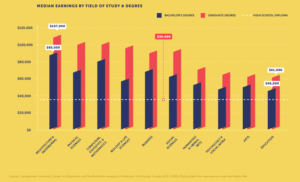Earning a credential of value is still the surest path to success for American workers. A recent New America poll released last month finds that 80 percent of American adults believe there are more opportunities for those who pursue education after high school, compared to 14 percent who think it is better to enter the workforce right away.
For adult learners, the connection between education and careers is even more important. According to Public Agenda, 71 percent of adult prospective students — those who are actively working to go back to school — say that their primary motivation is either to get ahead in their current career or to get the skills they need to start a new career.
Studying the return on investment for credential earners can be quite an undertaking, however, considering the vast number and types of credentials on the market today. Credential Engine, a nonprofit dedicated to counting and cataloging every credential, estimated in April that there are more than 330,000 individual credentials available in the United States today, and only a fraction of them are available at four-year institutions. That count includes nearly 67,000 postsecondary certificates, 13,600 Registered Apprenticeships and 5,400 certifications.
It is well understood that a university education can improve career opportunities. But where to start? Does major matter? And what is the return on investment for other sub-baccalaureate credentials like associate degrees, postsecondary certificates and industry certifications?
More Advanced Credentials Lead to Higher Earnings, but Field of Study Matters

With so many credentials on the market, how can learners navigate the education marketplace and find the credential that best suits their career interests and economic goals?
New research out of the Georgetown Center for Education and the Workforce helps us begin to demystify the credential marketplace.
The report finds that, while median income rises with more advanced credentials, the field of study matters a lot. A bachelor’s degree in architecture and engineering, for example, will land you a median salary of $85,000, far above the $46,000 median salary for education majors. Further, less education can even lead to higher earnings, depending on the field of study. Associate degree holders who study science, technology, mathematics and engineering (STEM) earn a median salary $13,000 higher than workers with bachelor’s degrees in psychology & social work. Certainly, credentials help learners unlock career success and earn a family sustaining wage, but field of study is far more important than level of education.
A separate Georgetown study puts a magnifying glass up to one particular type of credential, postsecondary certifications, examining earnings for individuals who earned a certification at an Oregon community college. The study finds that, on average, certification earners experienced a 19 percent increase in earnings. And Pell students experience an even larger premium, more than 50 percent of their wages prior to enrollment, further demonstrating the power of short-term certifications to provide an on-ramp to a sustainable career.
How Can States Help Learners Navigate the Credential Environment?
As the universe of postsecondary credentials continues to grow, learners will need support and guidance to help determine which credentials to pursue and where to pursue them. Already, a number of states have developed protocols to review, verify and publish a list of high-quality, industry-recognized credentials for secondary and postsecondary students. A new 50-state scan from the Workforce Data Quality Campaign finds that 30 states identify or plan to identify credentials of value at the state level. However, only 23 states report that they analyze employment and earnings outcomes and only 21 seek regular employer input.
If credentials are going to deliver on their promise, the credentialing system must be transparent and learners must be able to know which credentials are valued in the marketplace and recognized by employers. It is important for states to set up systems to regularly gather and put to use employer input. The evidence is encouraging, but there is still a lot of work to do to help demystify the credentialing marketplace and empower learners to achieve their career goals.
To learn more about credentials of value or state strategies to promote high-quality credentials, visit the Learning that Works Resource Center.
Austin Estes, Senior Policy Associate
